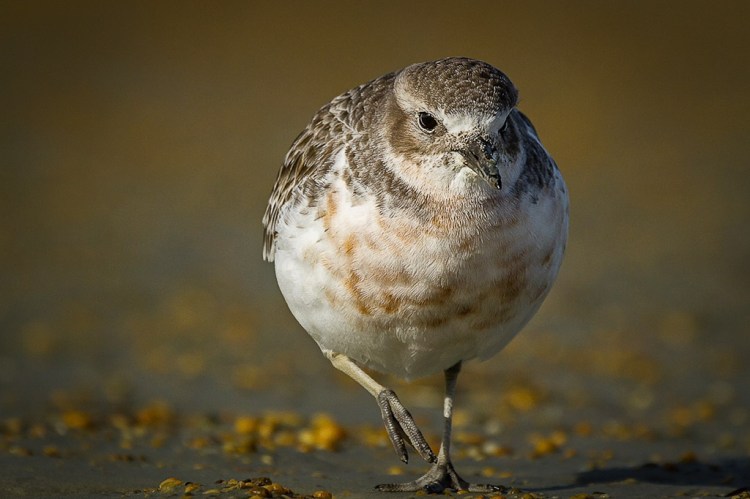Rachel Hufton of Illuminate Ecology, reports following a cannon netting bird banding trip at Awarua Bay, Invercargill, an important wintering site for the South Island New Zealand dotterel. A Nationally Critical Threatened Species of conservation concern.

above: South Island dotterel with South Island pied oystercatcher and a bar-tailed godwit at high tide roost site, Awarua Bay, Invercargill
The New Zealand dotterel is an endemic shorebird which was once widespread throughout NZ until the late 19th Century. Since then it has seriously declined in range and numbers and is now found in two distinct breeding populations. The two sub-species were first recognised in 1994; the North Island dotterel Charadrius obscurus aquilonius (Nationally Vulnerable) and the South Island Dotterel Charadrius obscurus obscurus (Nationally Critical).
The northern dotterel is more numerous, found on or near to the coast (mainly on the shores of the Eastern North Island). The southern dotterel was widespread but now only breeds on Stewart Island wintering here at the coast or at Awarua Bay in Invercargill (a popular wintering site for shorebirds) feeding on intertidal mudflats. It is generally a larger bird, with a heavier build than the northern dotterel and tends to be darker in colouration. Biometric measurements for bird (e.g. mid-toe) and egg are also different.


above: South Island dotterel Awarau Bay in breeding plumage and returning to basic plumage – Photography credit for both above Glenda Rees
The breeding habitat of the New Zealand dotterel is the most defining difference between the two sub-species. The North Island dotterel nests within an impression on beaches where as the South Island dotterel is more terrestrial nesting in the herb rich hills of Stewart Island, above the tree-line.
The population of South Island dotterel sub-species was at its lowest 25 years ago at 62 birds. Since then, considerable efforts targeting pest control have increased the population. The current population is now around 153 individuals. This is a decline from previous recovered population of 290 in 2009 as a result of a targeted cat (feral) control regime. This was however no longer solely effective and the population fell to 126 birds in 2016. The population appears to fluctuate and a slight increase is to be treated with caution as these birds are potentially at risk of extinction, especially in relation to further threats now identified by the NZ Dept. of Conservation (DOC) (highlighted below).
DOC Trail cameras installed at nest sites on Stewart Island have identified further threats to this critically vulnerable species such as the Australasian harrier, spur-wing plover and white-tailed deer, which have been observed taking eggs from nest sites. Accumulative threats have also resulted in a sex ratio imbalance, as males have been found to incubate eggs at night and therefore more susceptible to predation.
In light of historical population trends, DOC are now actively developing further conservation action planning for the South Island sub-species. This forms a ramp up on invasive predator control including new toxin targeted at cats, rat control, variety of kill traps and control of other predator species such as spur-winged plover. There will be active nest surveillance, cameras installed and field monitoring rangers. Further birds will also be colour banded to help monitor adult survival, abundance, site fidelity and to screen for disease such as avian malaria.
This work has started, and on 6 June 2017 additional South Island dotterels were captured at one of their wintering sites, Awarua Bay, Invercargill by a OSNZ cannon netting team working alongside DOC Invercargill. Below shows the cannon netting site set up where birds roost during high tide.

above: Cannon netting site at Awarua Bay, Invercargill at low tide.
All birds (adults and juveniles) were colour banded, processed and screened to help provide a better understanding, aid monitoring and guide conservation management of this species. Colour bands provide a unique identification code and allow birds to be identified and monitored more easily in the field (*no birds were injured or harmed during cannon netting).

above: Adult South Island dotterel with unique colour band identification. Note: wide bill, large eye and pale legs. High tide roost site in the background with bird observation optics
This article highlights the importance of species population monitoring to guide effective conservation management. With concentrated efforts in place from a broad alliance of conservationists, there is hope of saving this endemic New Zealand shorebird for future generations.
References
Images by Rachel Hufton and where stated Glenda Rees.
Carter, K (2017). Saving the Southern New Zealand Dotterel. Department of Conservation. Stewart Island. Presentation given at the OSNZ Conference Te Anau, June 2017.
Dowding, J, E (1994). Morphometrics and Ecology of the New Zealand Dotterel Charadrius obscurus with a description of a new sub-species. Notornis. Vol 1. Part 4.
http://nzbirdsonline.org.nz/species/new-zealand-dotterel
